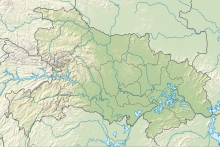
Back Slaget om vestlige Hubei Danish Batalla del oeste de Hubei Spanish نبرد غرب هوبئی Persian Bataille de l'ouest d'Hubei French Pertempuran Hubei Barat ID 江南殲滅作戦 Japanese Slaget om Vest-Hubei NB Batalha de l'oèst de Hubei Occitan Bitwa o zachodni Hubei Polish Битва за Западный Хубэй (1943) Russian
This article needs additional citations for verification. (August 2008) |
| Battle of West Hubei | |||||||
|---|---|---|---|---|---|---|---|
| Part of the Second Sino-Japanese War and the Pacific Theater of World War II | |||||||
| |||||||
| Belligerents | |||||||
|
|
| ||||||
| Commanders and leaders | |||||||
|
|
| ||||||
| Units involved | |||||||
|
| ||||||
| Strength | |||||||
| 280,000 | 120,000 | ||||||
| Casualties and losses | |||||||
|
23,550 killed 18,295 wounded 7,270 missing[1]: 137 |
25,000 killed and wounded 40 aircraft destroyed 122 naval vessels damaged or sunk[2] | ||||||
Location within Hubei | |||||||
The Battle of West Hubei (simplified Chinese: 鄂西会战; traditional Chinese: 鄂西會戰; pinyin: È Xī Huìzhàn), was one of 22 major engagements between the National Revolutionary Army and the Imperial Japanese Armed Forces during the Second Sino-Japanese War. It was also one of four major battles that took place in Hubei.
The battle resulted in a Chinese strategic victory, although they lost more troops than the Japanese Army. Historian Barbara W. Tuchman, however, writes that the "Japanese withdrew without pursuit from what appeared to have been a training and foraging offensive to collect rice and river shipping."[3] However, he also states that the battle ended in a tactical draw. The Chinese government reported that the Chinese had scored a major victory.[4] Japanese troops retreated to their former positions.
- ^ 陳敬堂 (15 July 2014). 《寫給香港人的中國現代史》. 香港: 中華書局(香港). ISBN 978-988-8290-82-6.
- ^ "鄂西大捷 徹底擊潰日軍13師團 滇西展開反攻". 鐵血映丹心. 青年日報. 31 May 2015.[permanent dead link]
- ^ Barbara Tuchman, Stilwell and the American Experience in China, pp. 373
- ^ "China Handbook". 1937.

